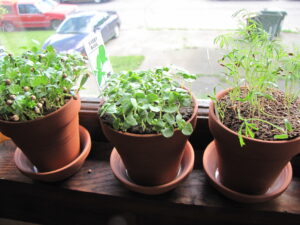 Herb gardens are great. They are one of the most useful, and versatile types of gardens you can grow. Outdoors, herbs can bring beauty, fragrance, and flavor to your landscape. Indoors, herbs can brighten up your home and give your cooking a fresh kick in the dog days of summer or the dead of winter.
Herb gardens are great. They are one of the most useful, and versatile types of gardens you can grow. Outdoors, herbs can bring beauty, fragrance, and flavor to your landscape. Indoors, herbs can brighten up your home and give your cooking a fresh kick in the dog days of summer or the dead of winter.
Whether you are growing an herb garden indoors or out, light is a very important factor to consider. Generally, it is ideal to give your herbs a minimum of six hours of direct sunlight per day. Western and southern exposures are ideal. Indoors, if you do not have a west or south facing window to put your herb garden in, you will likely need supplemental lighting. There are many great grow lights that can be purchased, but they can be a little pricey. To keep it cheap, you can use two 40 watt white fluorescent bulbs, and leave them on your plants for about 14 hours per day.
Soil is another important thing to consider. Here in Colorado, we tend to have alkaline soil that is often low in organic matter. Outdoors, before planting your herb garden, you can mix in plant-based compost to a depth of about 24 inches. This will help to build organic matter and give your herbs a light dose of nutrients as well. For herbs in containers, you can use a soilless media, which is readily available at many garden centers. There are also soil mixes, but you should be sure it is free of weed seeds, insects, and diseases.
Water may be the most important consideration to make when growing a great herb garden. You should check the plant tag for the herbs you buy, or do some research, to figure out what their water requirements are. Drip irrigation is preferable for in ground gardens, because overhead watering tends to promote disease. Containers will usually require more watering than in ground gardens. The amount of water depends on the size and material of the container, the type of plant, and the environment the plant is in. Water containers at the base of the plant and try to avoid splashing the leaves. Overwatering your herbs makes your chances of attracting pests or getting fungal diseases much greater.
Harvesting your herbs may be the most exciting part of herb gardening. Outdoors, harvest in the morning on a sunny day with no rain, after the dew has dried. Indoors, harvesting can be done whenever the herbs are needed. It is generally best to harvest the outer leaves first. Never take more than one third of a perennial plant at a time, and for annuals, leave at least four inches of plant so you can have more harvests. If you plan to use the leaves of the plant, you should pinch off any flowers that grow.


